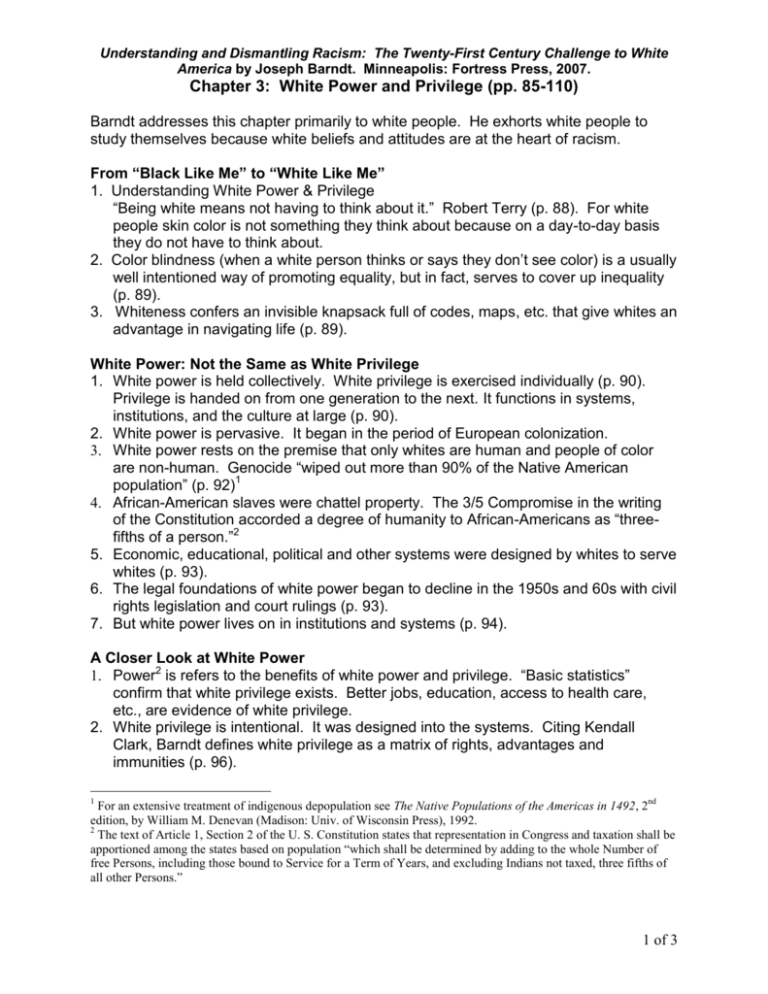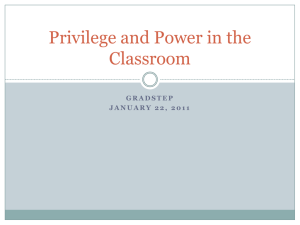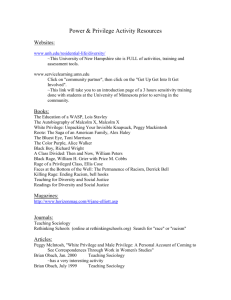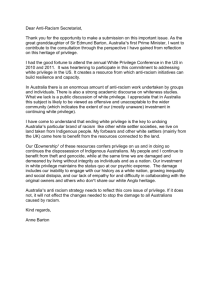Understanding and Dismantling Racism: The Twenty
advertisement

Understanding and Dismantling Racism: The Twenty-First Century Challenge to White America by Joseph Barndt. Minneapolis: Fortress Press, 2007. Chapter 3: White Power and Privilege (pp. 85-110) Barndt addresses this chapter primarily to white people. He exhorts white people to study themselves because white beliefs and attitudes are at the heart of racism. From “Black Like Me” to “White Like Me” 1. Understanding White Power & Privilege “Being white means not having to think about it.” Robert Terry (p. 88). For white people skin color is not something they think about because on a day-to-day basis they do not have to think about. 2. Color blindness (when a white person thinks or says they don’t see color) is a usually well intentioned way of promoting equality, but in fact, serves to cover up inequality (p. 89). 3. Whiteness confers an invisible knapsack full of codes, maps, etc. that give whites an advantage in navigating life (p. 89). White Power: Not the Same as White Privilege 1. White power is held collectively. White privilege is exercised individually (p. 90). Privilege is handed on from one generation to the next. It functions in systems, institutions, and the culture at large (p. 90). 2. White power is pervasive. It began in the period of European colonization. 3. White power rests on the premise that only whites are human and people of color are non-human. Genocide “wiped out more than 90% of the Native American population” (p. 92)1 4. African-American slaves were chattel property. The 3/5 Compromise in the writing of the Constitution accorded a degree of humanity to African-Americans as “threefifths of a person.”2 5. Economic, educational, political and other systems were designed by whites to serve whites (p. 93). 6. The legal foundations of white power began to decline in the 1950s and 60s with civil rights legislation and court rulings (p. 93). 7. But white power lives on in institutions and systems (p. 94). A Closer Look at White Power 1. Power2 is refers to the benefits of white power and privilege. “Basic statistics” confirm that white privilege exists. Better jobs, education, access to health care, etc., are evidence of white privilege. 2. White privilege is intentional. It was designed into the systems. Citing Kendall Clark, Barndt defines white privilege as a matrix of rights, advantages and immunities (p. 96). 1 For an extensive treatment of indigenous depopulation see The Native Populations of the Americas in 1492, 2nd edition, by William M. Denevan (Madison: Univ. of Wisconsin Press), 1992. 2 The text of Article 1, Section 2 of the U. S. Constitution states that representation in Congress and taxation shall be apportioned among the states based on population “which shall be determined by adding to the whole Number of free Persons, including those bound to Service for a Term of Years, and excluding Indians not taxed, three fifths of all other Persons.” 1 of 3 Understanding and Dismantling Racism: The Twenty-First Century Challenge to White America by Joseph Barndt. Minneapolis: Fortress Press, 2007. Chapter 3: White Power and Privilege (pp. 85-110) A Closer Look at White Privilege 1. Looking at the statistics is important because many whites deny the reality of white privilege. 2. A right is something for everyone and is enforced by laws. A privilege is an advantage for some, but not for everyone (p. 97). 3. A partial list of privileges for whites includes the following (p. 98): a. Higher salaries and economic benefits such as easy access to banking systems. b. Access to better housing c. Access to better health care d. Better treatment in the criminal justice system e. Easier acceptance of ideas f. Shopping without be suspected of stealing g. Manufacturers and service providers provide things for whites as mainstream. POC have “ethnic” products and services 4. Three exercises in discerning and naming white privilege a. Family history—first categorize yourself. Did you inherit wealth and position? Was your family relatively well off? Did you come from a poor family? How did social position influence your attitudes and beliefs about people of color? What was your family’s direct involvement in racial conflict? What is your personal story? (pp. 99-102). b. Investigating your daily environment—invite a friend of color to go different places with you. Is there a difference in the way you are treated, singly or as a twosome? do a media survey with your friend—how our your respective groups portrayed? Compare and contrast your experiences? (pp. 103-105). c. Personal Inventory of Daily life—as a white person I . . . (fill in the blank). Conclusion: “Everything goes better with whiteness” (pp. 105-106). Responses to White Power and Privilege 1. Barndt asks white people to assess their reactions and notice the paradigm shift that happens as awareness increases. The need to study systems of racism and figure out how to change them becomes apparent (p. 107). 2. Keep digging and practice your analysis skills. Tell the truth about yourself and about white people (p. 107). 3. White power and privilege is the “elephant in the room.” Truth telling is vital for cross racial relationships that attain true mutual respect (p. 108). 4. Guilt and shame are typical reactions as awareness increases. Guilt can be incapacitating. Move on to seek forgiveness (p. 108-109) 5. If you are a white person, acknowledge that you simultaneously hate and love white privilege (p. 109). 6. As a white person, one cannot discard whiteness. It is always with one and cannot be put aside. Privilege is always there. 2 of 3 Understanding and Dismantling Racism: The Twenty-First Century Challenge to White America by Joseph Barndt. Minneapolis: Fortress Press, 2007. Chapter 3: White Power and Privilege (pp. 85-110) 7. Collectively white people can transform their power and privilege. They need to understand Power3, that racism harms everyone, whites and people of color (p. 110). Discussion Questions for Chapter 3: White Power and Privilege (pp. 85-110) 1. See A Closer Look at White Privilege, 4 a on the outline. What is your family story in regard to awareness of race and racism? What are the implications for your behavior now? 2. If you are White, think about Whiteness as an attribute. As you learn more about anti-racism, what does being White mean to you now? 3. If you are a Person of Color, what are some of the implications for you if more White people understood Whiteness. 3 of 3






